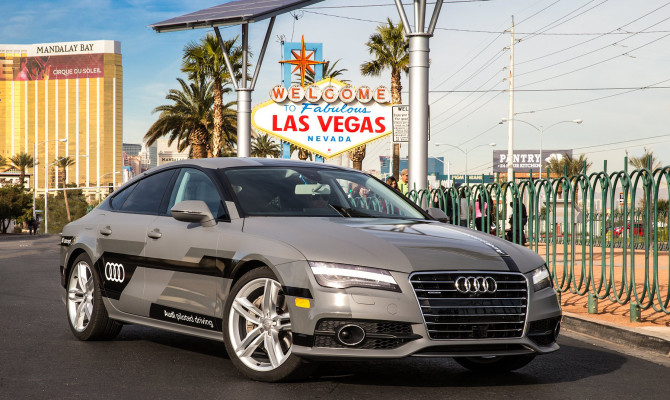“The deep learning process is at the centre of a drive to produce a commercially available vehicle that can pilot itself to any destination with little human help.”
As Audi perfects its autonomous driving technology, it’s using ‘deep learning’ to train computers to imitate the human brain.
This breakthrough played a critical role for a recent 885-kilometre autonomous-drive of “Jack,” the Audi A7 Sedan from Silicon Valley to Las Vegas. The deep learning process is at the centre of a drive to produce a commercially available vehicle that can pilot itself to any destination with little human help. Audi is cooperating with such key suppliers as NVIDIA, the digital-tech company based in Santa Clara, California, to create a vehicle computer the way human brains process new information.
To understand the concept, think of the car’s way of learning as being similar to that of child. Caregivers teach a baby to identify things perceived with senses: a circle, a square, colors. Object edges are very important in this process. The edges form meaningful, distinct shapes, which the brain starts to recognize. A fire truck is red, has a certain shape and wheels, but at first, the baby might think all trucks are fire engines. Then the child learns to differentiate between different kinds of trucks.
The car technology enables pixels to be generated by camera images, in a similar way to how the human eyeball transfers images to the brain. The Audi processor, about the size of a tablet PC and powered by NVIDIA’s Tegra processor, analyzes every frame of video that comes in, and it senses edges which it groups into shapes. It learns that the shapes are objects then learns to differentiate those objects.
This artificial intelligence enables the Audi processor to detect, for instance, features such as eyes, a nose and mouth, and it figures out that they all fit into a face. It also allows vehicles to detect and identify other vehicles. All of this information goes into a database to foster future advances in such recognition. The system serves as one of the important bases of intelligence for piloted driving.
With every kilometre travelled, the car gets smarter. But it takes more than terabytes of such data to make for successful autonomous driving. The data has to be processed very quickly: 30 video frames a second. The information must be transmitted, recognized, processed, analyzed – and provide a reaction – almost instantaneously, in case a driver is encountering dangerous conditions.
That’s why one of the most important objectives of deep learning is to ensure that every bit of object recognition is embedded in the processor in the vehicle itself and is not dependent on the internet cloud.
Of course, we hope Audi will not incorporate some driver thought processes into this deep learning technique!
(Story features files from Newspress.)
Contact the writer at keith [dot] morgan [at] drivewaybc [dot] ca
Recent Comments
- { Enjoyed your Forest of Bowland in the BMW X5M, particularly the photo of the BMW in front of the main part of Stonyhurst College where... }
- { Bantam designed the Jeep, not Willy's or Ford. The American military gave the original Bantam prototype to Willys and Ford to copy. There is plenty... }
- { All Escalades come with a 6.2-lilter V8 engine that produces 420 horsepower. A six-speed automatic is the only transmission offered and drives the rear wheels.... }
- { Alexandra is an excellent journalist. }
Popular Posts
- Journey to a ‘Sparkling’ Luxury Okanagan Resort “Four lucky readers will put a Dodge Journey’s weekend-...
- The Need For Speed: Hike Those Highway Limits More than half of those polled believe the province sho...
- Drives-U-Crazy… Erratic drivers. An early morning drive from Kelowna to Vancouver is nor...
- Readers Respond: The Pros and Cons of Increasing B.C. Speed Limits Increasing the speed limits will only increase risk to...
- Honda CR-V Review: The Compact Crossover To Get Things Done The CRV is a very stylish and aerodynamic crossover veh...







